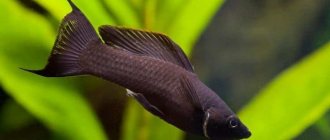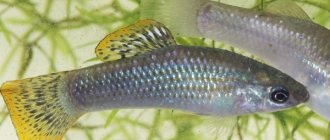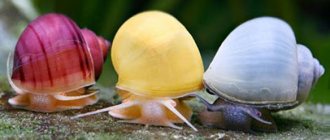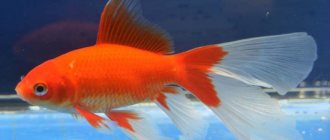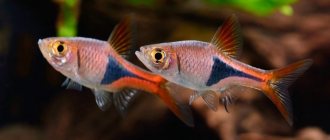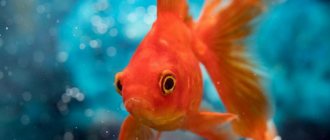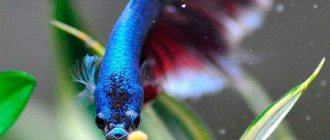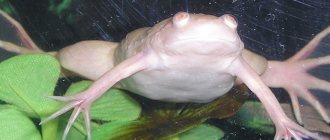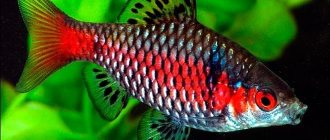Mollies (lat. Mollienesia) are the best choice for beginner aquarists. These fish have many advantages - they are unpretentious, friendly and omnivorous. In the wild, mollies live in fresh and brackish waters of Central America. Wild species are divided into two groups: those with short fins and those with long fins. Fish first appeared in aquariums in 1899. A wide variety of colors, shapes and sizes have been obtained through selective breeding, but three species are most often found in aquariums: Molliesia velifera, Molliesia sphenops and Molliesia latipinas. Hybridization for the purpose of breeding new breeds is still relevant today.
Known species of mollies
Molliesia Velifera. It is distinguished by a well-developed dorsal fan-shaped fin in the male. The body size can reach up to 5 cm. The natural color of the body is silver with horizontal dotted lines, the front part of the body is sometimes painted a pleasant orange color. The tail is turquoise on the periphery and orange in the middle. Females have a grey-green body. The fish is very active and requires a large space for swimming. In its natural environment it feeds on mosquito larvae. Loves slightly salty water.
Molliesia sphenops. It has a dense, elongated and laterally compressed body, a well-developed round fin. Body size: 6-10 cm. The most popular color is pure black. But there are artificially produced white, yellow and speckled ones. The most valuable are considered to be mollies with black velvet scales, whose large black eyes are practically invisible. Sphenops swims preferably in the upper and middle layers of water. They often jump out of aquariums that are not covered with a lid.
Molliesia latipin. It is very similar to the Velifera molly, but is smaller in size. The color is most often bluish-gray. Males are more greenish. The sides are strewn with shiny white dots arranged in rows. The lower part of the body is bright orange.
History of discovery
Achille Valenciennes
Mollies sphenops is the first species in history, which was described by the French zoologist Achille Valenciennes back in 1846. At this time, he was working on writing his 22-volume work, “The Natural History of Fishes.”
50 years have passed, and two species at once fell under the description - velifera and free-ranging mollies. This merit belongs to the ichthyologist-systematist Charles Tate Regan.
1913 - The first wild mollies latipin arrives in Europe.
Charles Tate Regan
Interestingly, the fish were originally assigned to the genus Mollienesia. But modern classification has made clarifications, and now they belong to the genus Poecilia. And their very name Mollienesia is a historical legacy from the original classification.
The year 1920 can be marked as the year of the beginning of active breeding work to develop new forms of mollies. Thanks to the successful crossing of species such as Sphenops, Velifera and Latipine, new hybrids began to appear one after another. A major achievement was the introduction of the black and speckled uniform in 1925. But perhaps the most famous and popular breed was the black-velvet molly, called Black Molly. In the mid-twentieth century, it was so popular that even today, when many lovers mention mollies, they first of all associate with Black Molly. One of the latest breeding trends has been the breeding of mollies, which, due to their similar shape, are called balloons.
Maintenance and care
As mentioned earlier, due to their simplicity and unpretentiousness, mollies are suitable for keeping by beginning aquarists. They are able to adapt to a wide range of water parameters. But it is still recommended to maintain the most optimal conditions in the aquarium. The water temperature should be 23-28 degrees. Both neutral and slightly acidic water (pH= 7-8) is suitable. They feel great in hard water.
The ideal volume of an aquarium is 50-70 liters, depending on the number of fish living in it. The aquarium must be provided with good filtration and the water must be changed regularly. Fish are light-loving, so take care of bright lighting.
Mollies love to eat the leaves of some plants and scrape algae from the surface of decorations and soil. It will be useful to plant the aquarium with live plants. Sand or fine gravel is ideal as a soil.
Feeding the fry
In a community aquarium, it is difficult to feed the fry anything special. All the inhabitants constantly swim to the smell and visibility of food. At first, the fry will definitely find suitable food on plant leaves, stones and snags. However, 3-4 meals a day will not hurt. To do this, you can use ready-made food from the store. Feeding ciliates and brine shrimp has a good effect on growth. If you use tubifex, you will have to chop it very finely. Large food particles can kill young people.
Mollies in nature are mostly vegetarian. Feeding with plant food guarantees to raise a healthy generation.
How do they reproduce?
Breeding mollies requires virtually no effort; even a beginner can handle it.
The fish are viviparous - the fry is born fully formed and capable of independent life.
Pregnancy is determined by several signs: a swollen abdomen, an enlarged dark spot near the anus, swelling of the anus, and frequent solitude of the female in dense vegetation. Female mollies are highly fertile. The age and size of the female affects the number of fry (50 – 350 fry). To prevent the newborn fry from being eaten by other inhabitants of the aquarium, it is better to place the pregnant female in a separate spawning aquarium, or to provide the offspring with a large number of different shelters and plants.
Pregnant female molly
Preparing individuals for reproduction
Breeding mollies at home does not cause any trouble for the aquarist if he follows simple rules. First you need to prepare a separate aquarium, in which there will be a lot of vegetation and the water temperature is maintained at the level necessary for the fish.
Anal fin - a sharp difference between the male
Determination of gender
It is quite easy to distinguish between male and female mollies based on some features. Females are larger than males and have a triangle-shaped anal fin. The fish becomes sexually mature and ready to mate within 5 months after birth.
A distinctive feature of males is the anal fin - it has the shape of a tube. It will be ready for mating 8 months after birth.
If the conditions of detention require this, the fish changes sex to the opposite one. This function is inherent in all viviparous fish in order to preserve the population in the event of an emergency and the threat of extinction.
Requirements for an aquarium
It is important to maintain the water temperature no lower or higher than 28 degrees. Otherwise, the fry will be born ahead of schedule, and saving them will be quite difficult. Spawning of mollies can also occur in a general aquarium, but it is important to maintain the temperature regime and provide a sufficient amount of free space.
After the aquarium is prepared, you need to select a male and female that have completed puberty. They will begin to mate only if they like each other , otherwise they will have to choose other partners. Fertilization may not occur the first time, so the couple should be left in the same house for several days. But with a successful combination of circumstances, fertilization will occur the first time, and the offspring will appear within a month.
It is better to remove the male before giving birth
Definition of pregnancy
When a female's abdomen becomes round, we can safely say that she is expecting offspring. The pregnancy process lasts up to 10 weeks. At a time, a female is capable of giving birth to from 30 to 200 fry, but the latter option is applicable only to large individuals.
Before giving birth, the male must be removed from the aquarium, but this will not affect the birth of the babies. The female is able to retain fertilized cells for quite a long time. Childbirth occurs every two or three months and continues throughout the year. The participation of the male in this process is not required.
By knowing how often mollies give birth, you can control the number of fry. And if the aquarium conditions are completely ideal, then the offspring will be strong and healthy. But to obtain offspring from one species, one must strictly ensure that both parents belong to the same species.
Caring for fry
Mollies reproduce in an aquarium without any particular difficulties. The fry are born almost transparent and completely merge with the water. They do not require special care, but it is still worth monitoring their vital activity. The fry feed independently and do not need parental care.
After giving birth, the female should be placed in a separate aquarium. They usually do not eat their young, but there are cases where the fry are completely eaten. For kids, you should prepare a separate 40-liter aquarium to give them some space.
Don't forget to maintain the optimal temperature
The temperature should be constantly maintained at 26 degrees. The fry react very sharply to its change and may die. Water must be filtered and oxygenated daily. It must be changed at least once a week. There are no differences in care from adult fish, so there will be no difficulties with this.
For feeding, you can use the same food as for adult mollies, only it should be crushed first. Food should be given often and little by little , because the fry grow very quickly.
How to distinguish a male from a female
The choice of a pair of sires plays an important role in obtaining healthy offspring. This is not difficult, since mollies have pronounced sexual dimorphism. As a rule, males are much smaller than females and have a mobile gonopodium - a modified anal fin that serves as a reproductive organ. Sexual maturity in fish occurs at 8-12 months for males, and at 5-6 months for females. When selecting, you need to pay attention to the strongest, most active and beautiful individuals.
Possible gender reassignment
On the Internet on aquarium forums there are stories about how mollies change their sex. The female turns into a full-fledged male who is capable of fertilizing females. As they write, this is influenced by the conditions of the fish, for example, the difference in water temperature, and does not depend on age. Although this is rare.
Other lovers of this type of fish explain the appearance of a gonopodium (male genital organ) in the female as a hormonal imbalance. In this case, they are not talking about a full-fledged “sex change,” because the reborn female cannot perform the functions of a male. The changes concern only the appearance of the fish.
Most amateur naturalists and representatives of science explain this not by a change of sex, but by the process of manifestation of the characteristics of female or male individuals or prolonged maturation.
Visually, molly fry are similar to females and do not express obvious sexual differences. An immature male is mistaken for a girl. Time must pass before his male characteristics appear and he becomes ready for procreation. For such fish, a special term “late males” was even introduced.
Diseases
Even such unpretentious fish are vulnerable to some diseases:
• Gas embolism – accumulation of excess oxygen and further blockage of blood vessels. The fish becomes restless, the gill covers gradually darken, sometimes the eyes become cloudy and bruises are visible. The disease occurs when a large volume of tap water is poured into an aquarium without first settling. For prevention, it is necessary to settle the water to fill the aquarium. • Colds - accompanied by refusal to eat and decreased activity. Occurs when the temperature drops sharply. It is treated by maintaining a constant optimal water temperature in the aquarium. • Infestation – when infected with parasites, the fish begins to worry, and a painful coating appears on the surface of the body. In case of such diseases, water is treated with special preparations. • – sick fish experience changes in behavior and appearance. Treatment is selected depending on the type of infectious disease.
Compatibility with other fish
Thanks to their boundless friendliness, mollies are ideal for keeping in a community aquarium and are compatible with all peaceful fish. But it is important to consider that they cannot be kept together with predatory or aggressive species. Fights may occur between male mollies.
Ideal neighbors: • Guppies • Swordtails • Danios • Corydoras
Mollies are very popular among aquarists. Various exhibitions and scientific conferences are held around the world, where you can see the best representatives of various breeds and color variations. Due to their unpretentiousness in maintenance and care, such fish are ideal for the very first aquarium in your life.
